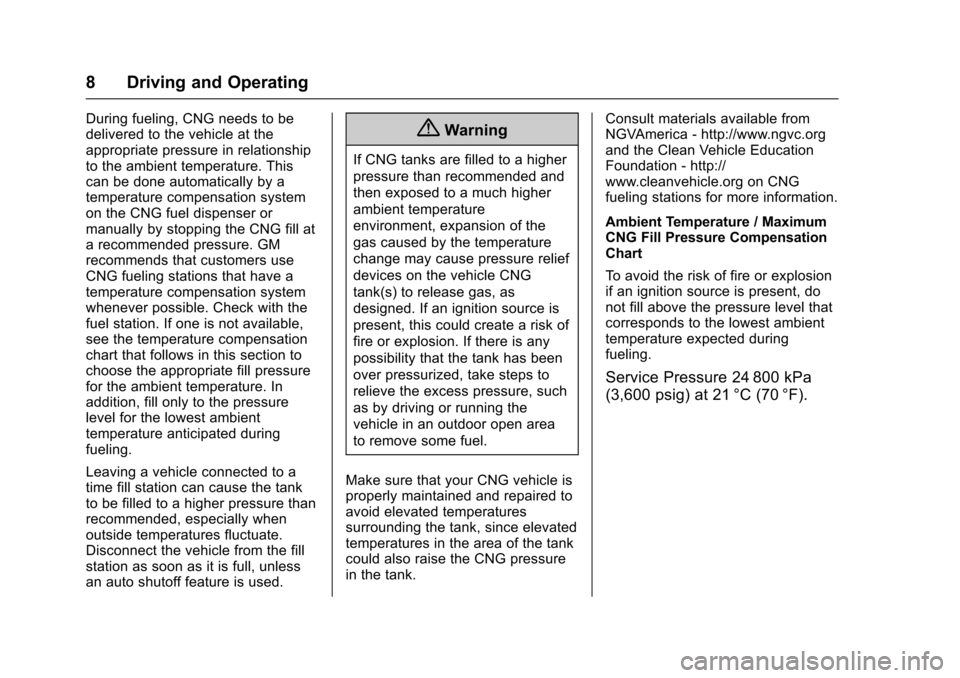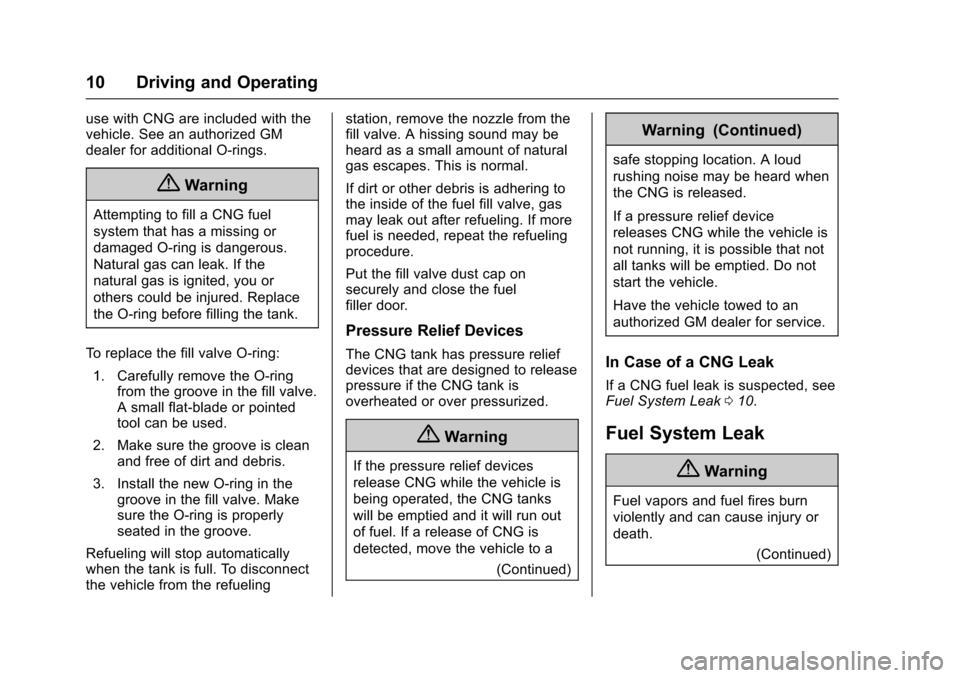fuel fill door release CHEVROLET EXPRESS CARGO VAN 2016 1.G CNG Manual
[x] Cancel search | Manufacturer: CHEVROLET, Model Year: 2016, Model line: EXPRESS CARGO VAN, Model: CHEVROLET EXPRESS CARGO VAN 2016 1.GPages: 30, PDF Size: 0.63 MB
Page 9 of 30

Chevrolet/GMC Express/Savana CNG Compressed Natural Gas Supplement
(GMNA-Localizing-U.S/Canada-9159237) - 2016 - crc - 6/18/15
8 Driving and Operating
During fueling, CNG needs to be
delivered to the vehicle at the
appropriate pressure in relationship
to the ambient temperature. This
can be done automatically by a
temperature compensation system
on the CNG fuel dispenser or
manually by stopping the CNG fill at
a recommended pressure. GM
recommends that customers use
CNG fueling stations that have a
temperature compensation system
whenever possible. Check with the
fuel station. If one is not available,
see the temperature compensation
chart that follows in this section to
choose the appropriate fill pressure
for the ambient temperature. In
addition, fill only to the pressure
level for the lowest ambient
temperature anticipated during
fueling.
Leaving a vehicle connected to a
time fill station can cause the tank
to be filled to a higher pressure than
recommended, especially when
outside temperatures fluctuate.
Disconnect the vehicle from the fill
station as soon as it is full, unless
an auto shutoff feature is used.{Warning
If CNG tanks are filled to a higher
pressure than recommended and
then exposed to a much higher
ambient temperature
environment, expansion of the
gas caused by the temperature
change may cause pressure relief
devices on the vehicle CNG
tank(s) to release gas, as
designed. If an ignition source is
present, this could create a risk of
fire or explosion. If there is any
possibility that the tank has been
over pressurized, take steps to
relieve the excess pressure, such
as by driving or running the
vehicle in an outdoor open area
to remove some fuel.
Make sure that your CNG vehicle is
properly maintained and repaired to
avoid elevated temperatures
surrounding the tank, since elevated
temperatures in the area of the tank
could also raise the CNG pressure
in the tank. Consult materials available from
NGVAmerica - http://www.ngvc.org
and the Clean Vehicle Education
Foundation - http://
www.cleanvehicle.org on CNG
fueling stations for more information.
Ambient Temperature / Maximum
CNG Fill Pressure Compensation
Chart
To avoid the risk of fire or explosion
if an ignition source is present, do
not fill above the pressure level that
corresponds to the lowest ambient
temperature expected during
fueling.
Service Pressure 24 800 kPa
(3,600 psig) at 21 °C (70 °F).
Page 11 of 30

Chevrolet/GMC Express/Savana CNG Compressed Natural Gas Supplement
(GMNA-Localizing-U.S/Canada-9159237) - 2016 - crc - 6/18/15
10 Driving and Operating
use with CNG are included with the
vehicle. See an authorized GM
dealer for additional O-rings.
{Warning
Attempting to fill a CNG fuel
system that has a missing or
damaged O‐ring is dangerous.
Natural gas can leak. If the
natural gas is ignited, you or
others could be injured. Replace
the O‐ring before filling the tank.
To replace the fill valve O-ring: 1. Carefully remove the O-ring from the groove in the fill valve.
A small flat-blade or pointed
tool can be used.
2. Make sure the groove is clean and free of dirt and debris.
3. Install the new O-ring in the groove in the fill valve. Make
sure the O-ring is properly
seated in the groove.
Refueling will stop automatically
when the tank is full. To disconnect
the vehicle from the refueling station, remove the nozzle from the
fill valve. A hissing sound may be
heard as a small amount of natural
gas escapes. This is normal.
If dirt or other debris is adhering to
the inside of the fuel fill valve, gas
may leak out after refueling. If more
fuel is needed, repeat the refueling
procedure.
Put the fill valve dust cap on
securely and close the fuel
filler door.
Pressure Relief Devices
The CNG tank has pressure relief
devices that are designed to release
pressure if the CNG tank is
overheated or over pressurized.
{Warning
If the pressure relief devices
release CNG while the vehicle is
being operated, the CNG tanks
will be emptied and it will run out
of fuel. If a release of CNG is
detected, move the vehicle to a
(Continued)
Warning (Continued)
safe stopping location. A loud
rushing noise may be heard when
the CNG is released.
If a pressure relief device
releases CNG while the vehicle is
not running, it is possible that not
all tanks will be emptied. Do not
start the vehicle.
Have the vehicle towed to an
authorized GM dealer for service.
In Case of a CNG Leak
If a CNG fuel leak is suspected, see
Fuel System Leak010.
Fuel System Leak
{Warning
Fuel vapors and fuel fires burn
violently and can cause injury or
death.
(Continued)